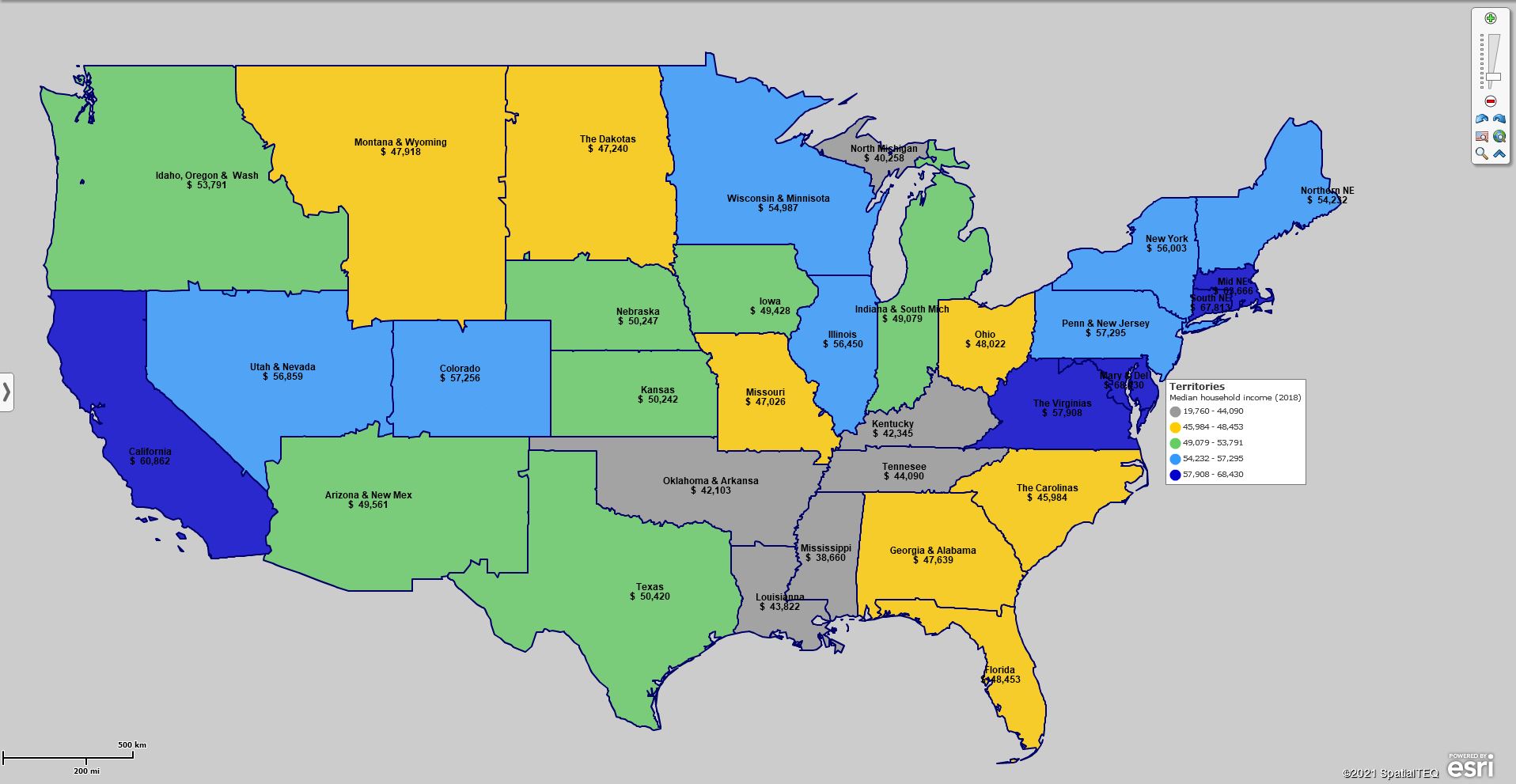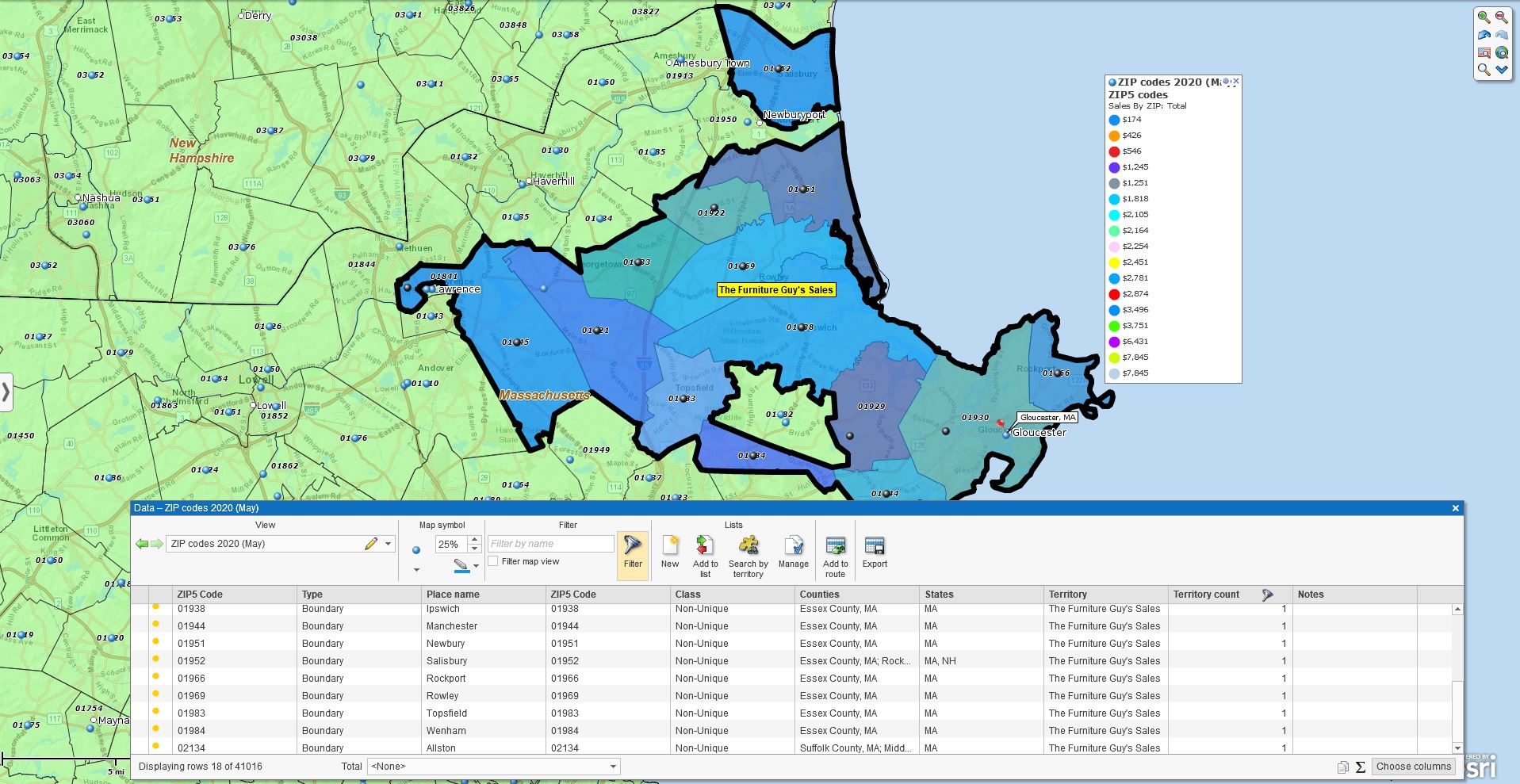The most common application of territory mapping, a feature of MapBusinessOnline, is sales territory mapping. Territory mapping is sales territory mapping for 90% of the MapBusinessOnline user base. The application of sales territories is common and wrestles with the same challenges other territory applications wrestle with namely these six tasks:
- Defining accountability
- Managing areas of overlap
- Controlling travel expenses
- Clearly communicating company goals and objectives
- Tracking progress against goals
- Organizing outside travel tiers
The value of sales territory mapping is linked directly to financial results. Sales results are often tracked, posted, and compensated for a given period through sales territory mapping. Expense reporting is also tracked against territory results. Sales trip and expense reporting usually include the submittal of travel receipts, mileage reports, airline stubs, brief write-ups of contacts made, negotiated contracts, and purchase orders. Sales territories organize the various sales pieces over a shared geographic coverage area.
Read More About Sales Territory Mapping
Sales Territory Mapping & Organizational Structure
Huge companies may require sales territories that roll up into regions and divisions, better known as hierarchical sales territories (MapBusinessOnline Pro). This way, management tiers are implemented to communicate clear company objectives across a sales force that could number into the thousands. Vice presidents at the division or national level oversee regional directors nationwide. Local sales managers supervise individual sales reps who travel within state or county jurisdictions.
Not all tiered sales operations follow this exact formula, but it is a common approach for online mapping software users. Simple sales territory maps usually suffice for companies catering only to regional areas.
Usually, sales territory maps are based on a business mapping application’s ZIP code map layer. ZIP codes provide familiar and manageable area segments for territories that often cover cities with dense populations. Counties are also popular if the organization caters to a more regional, rural, or state-wide audience. The state map layer tends to be used by large conglomerates or businesses that cater to a worldwide customer base.
Map layer choices usually reflect the traveling representative’s areas of accountability. Traveling business people, those submitting only occasional overnight hotel receipts, will be well suited to ZIP code-based territories. Expenses should also coincide with map layer realities. For example, expense submittals from ZIP code-based territories rarely include airline tickets. If they do, you may want to investigate.
While I don’t believe most salespeople pad their expenses, I know from experience it happens. The excellent news is expense padding is wicked easy to expose because receipts, phone records, and mileages tell the story. All you need to do is spreadsheet out the details. Maybe make a few calls to verify dinners etc. You’ll catch the blatant violators.
Demographic Analysis by Territory Segment
The US Census Bureau publishes demographic data that conveniently matches standard map layer segmentations. Sales territory mapping enables demographic data inclusion in support of market analysis, assignment logic, and product applicability studies. Promotes demographic data inclusion in support of market analysis, assignment logic, and product applicability studies. The US Census Bureau publishes demographic data that conveniently matches standard map layer segmentations. These demographic categories are varied and regularly updated, meaning territory analysis is extremely useful for market projections and territory assignments.
Available demographic data covers various subjects, including, population, consumer spending habits, housing data, household statistics, and more. A map creator may wish for additional categories that match a particular product or service requirement. If the data has a location component – a city, ZIP code, or county – a user can import that data into business mapping software. Don’t be shy about asking MapBusinessOnline about additional demographic layers. We’ll consider adding new categories that come up often.
Territory alignment is often demographically generated, especially for consumer-oriented products. Retail establishments may prefer to view consumer expenditure patterns or ethnicity data by county or ZIP code. For instance, pharmaceutical companies may assign territories to sales reps based on the population levels of elderly residents by city or ZIP code – Census categories for population ages 65 and up.
Impactful though demographic data may be, the most critical location data a business can bring to bear on territory mapping is its business location data. Historical sales data, customer locations, prospect locations, and other relevant location datasets magnify the power of territory mapping analysis. Viewing your key business measurements next to demographic categories can be very enlightening.
Additional Territory Map Segmentation
City limits, Census tracts, MSA’s, and ZIP3 Codes act in the same way as a ZIP5-Code map layer when applied. A City limits layer is ideal for urban area market studies. Less frequently, additional map layers serve as territory mapping segmentation.
Many companies must be tactical about sales coverages. Demographic data layered across urban areas is a telling projection of how the sale of a product or service will fare in that territory. Actively selling catheters in a New England college town is difficult to justify when Florida’s ever-aging population is buying up the USA catheter inventory faster than you can say UTI.
City limits or city limits grouped into urban territories ranked by demographic profile can indicate the most fertile areas for new distribution warehouses, retail stores, or sales hires. City limit demographic views are perfect for market expansion analysis and confirm the gut feeling of managers being asked to direct sales growth for expanding firms. Read more about market expansion in this case study.
Non-sales Related Territories
While most businesses use territory maps as sales territories, many companies use territory management for other applications. Specifically, technical support, medical home care agencies, and construction site management are examples of non-sales territory map applications.
Those six aspects of territory mapping I referred to earlier still apply. Construction managers track progress against goals and monitor expenses just like sales managers. Technical support teams will meet out areas of accountability and monitor their reps’ activities, including travel expenses to trouble spots, as required.
And traveling clinicians for homecare agencies may have the most challenging job. Homecare schedules are incredibly tricky. Unplanned cancelations, weather-related delays, and medical emergencies can all play a role in travel disruption, not to mention the incredible unpredictability of COVID-19 issues that can ruin a day. (Don’t get me started.) Within home care agencies, managing travel expenses and minimizing overlap while taking advantage of overlap are significant challenges.
Whatever your business’s challenges, territory management tools can help organize, communicate, and control areas of your mobile operations. Replace Microsoft MapPoint with MapBusinessOnline.
MapBusinessOnline territory mapping tools are available in both Standard and Pro subscription options.
Choose MapBusinessOnline Standard for basic sales territory mapping:
- Create territory alignments by polygon lasso or imported spreadsheet.
- Supports territory hierarchies – regions, divisions, and zones.
- Edit territory segments with mouse cursor clicks, polygon data collection, or through data filtering.
- Access complete demographic analysis views with location data reporting.
- Address overlapping territory concerns with color-coding options.
- Color-code territory assignments by demography or imported business data.
- Segment territories by ZIP5 codes, ZIP3 Codes, City Limits, Counties, States, Census Tracts, or MSAs.
Choose MapBusinessOnline Pro for advanced sales territory mapping:
- Includes all the features of MapBusinessOnline Standard.
- Supports territory hierarchies – regions, divisions, and zones.
- Automatically build multiple sales territories from radius searches or driving time and distance queries.
- Enrich imported dataset with demographic and geospatial data,
- Conduct map-based market analysis that combines geographic, demographic, and driving time analysis.
So, while territory mapping and sales territory mapping are virtually synonymous, pay attention to your organization’s unique requirements. Look for flexibility in your chosen applications, but remember, full customization of any software application can lead to the poorhouse.
_______________________________________________
Discover why over 25,000 business users log into www.MapBusinessOnline.com for their business mapping software and advanced sales territory mapping solution. The best replacement for Microsoft MapPoint happens to be the most affordable.
To access MapBusinessOnline, please register and download the Map App from the website – https://www.mapbusinessonline.com/App-Download.aspx.
After installing the Map App, the MapBusinessOnline launch button will be in the Windows Start Menu or Mac Application folder. Find the MapBusinessOnline folder in the Start Menu scrollbar. Click the folder’s dropdown arrow and choose the MapBusinessOnline option.
The Map App includes the Map Viewer app for free non-subscriber map sharing.
Please read customer reviews or review us at Capterra, or g2crowd
Contact: Geoffrey Ives geoffives@spatialteq.com or Jason Henderson jhenderson@spatialteq.com


